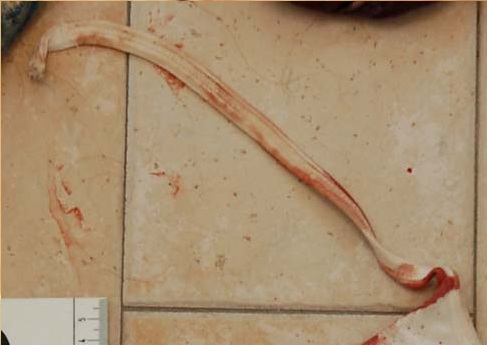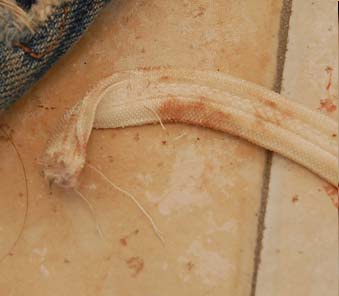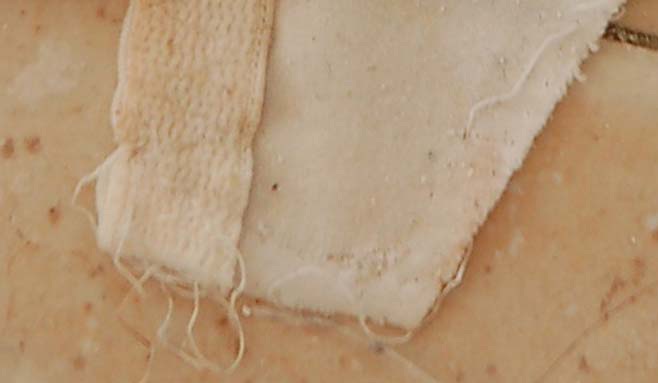How the enraged killer ripped the victim’s bra apart with his bare hands
When Meredith Kercher’s body was found the day after the murder, her bra was lying on the floor near her feet. A small portion of her bra, a clasp fabric with two hooks, was later found under a pillow which was under her body. A visual inspection indicated that both shoulder straps were severed. Also, the clasp fabric with two hooks had been severed from the right back strap. A reconstruction of the murder and sexual assault found that the killer, Rudy Guede, had severed the bra at both shoulder straps and the back strap fabric clasp hook section and had then pulled the bra off from the front. Recently, a close examination was undertaken of how the bra straps were severed. The only available quality detail photos of the victim’s bra were those taken at the crime scene. Unfortunately, these photos show only one side of the bra making it difficult to discern and understand the original bra design.
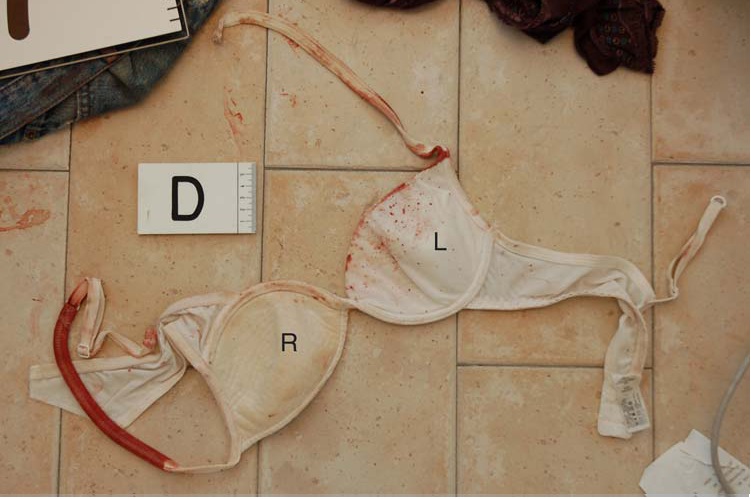 |
The photo above is the best overall photo of the victim’s bra shown with the breast cups reversed to each other and marked with L for left and R for right.
The exact make and model of the bra is also not currently known so an exemplar bra has not been examined. However a similar bra was examined along with viewing of bra designs over the internet. In examining the similar bra and comparing it to the photos of the victim’s bra, several similarities were noted in the basic construction of each bra. These similarities appear rather common from observing the construction of bra photos found over the internet.
Typical full cup bra design
The victim’s bra was found to be a full cup bra design with shoulder straps. Full cup bras with shoulder straps typically have cup receptacles for both breasts which are connected to each other with fabric and then with side or back straps that attach in the back of the wearer through a hook and loop attachment. Bras typically have shoulder straps that connect from the top of each bra cup over the shoulder to the respective back strap. The shoulder straps typically have an adjusting feature in the back which connects to the non-adjusting strap segment via a metal loop. The non adjusting strap is looped through the metal loop and sewn together at this loop connection. The left back strap typically terminates in the middle of the back with a clasp fabric loop receptacle section.
The right back strap typically terminates in a clasp fabric hook section which overlays the fabric loop section and attaches to the loop receptacles. The right shoulder strap typically attaches to the right back strap a few inches from the clasp fabric hook section and then is sewn along the upper fabric edge of the back strap where it ends and is sewn to the clasp fabric and hook section. The same general construction applies to the left shoulder strap with the exception of the end being at the clasp fabric loop section.
Examination of victim’s bra
A close inspection of the left shoulder strap indicates that this strap was separated at the metal loop connection on the back shoulder side. The non adjustable strap had failed at its threaded connection to the metal loop allowing the non adjustable strap to separate. The killer had to tightly grip the left shoulder strap to either side of the metal loop and then utilize a maximum pulling apart effort to induce failure in the threaded end of the non adjustable strap.
Thus, one would expect the four or five inch region to either side of the left shoulder strap metal loop to be a prime location to find skin and or blood cells belonging to the killer.
 |
Same photo as above with blue circles and dotted lines showing where the left severed shoulder strap had been connected. The green circles show where the end of the right severed shoulder strap had been sewn to the bra back strap where the fabric clasp hook had also been sewn.
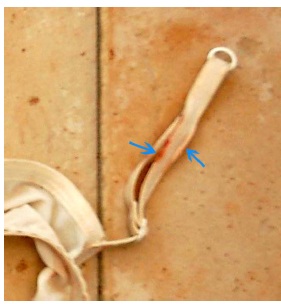
Above is a closeup of the adjustable section of the left shoulder strap showing the metal loop is lacking a non adjustable strap connection. The arrow on left points to a blood stain likely left by the killer’s hands and was either his or the victim’s blood. The arrow on right points to an irregular crease in the strap likely made by the killer’s tight grip needed to pull the strap apart at the metal loop.
Above is the non adjustable portion of the left shoulder strap whose end has been ripped from the metal loop by tearing open the sewn threads. Below is a closeup of the ripped open end showing torn sewing threads. The DNA of the killer is likely on this section of the strap as a result of the tight grip and pulling action needed to break the strap apart at the threaded connection.
Next, we consider the right shoulder strap. This strap was severed at the connection of the adjustable strap segment to the back strap. One end of the adjustable strap was sewn to the back strap for about two to three inches where it terminated at the connection of the clasp hook fabric. A close inspection of the right back strap indicates the right shoulder strap had been totally ripped off at the threaded connections.
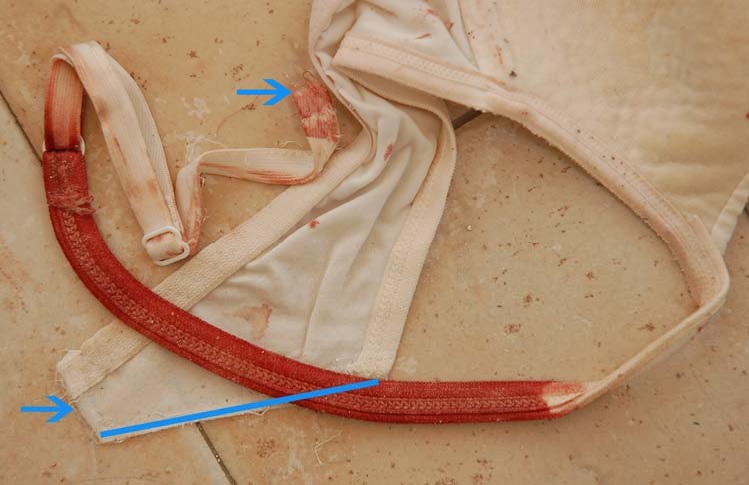 |
The photo above shows a closeup view of the right back strap and right shoulder strap. The end of the severed right shoulder strap is located at the upper arrow. This strap had been sewn along the blue line to the back strap where it ended at the clasp fabric hook section which had also been torn off and is not shown in this photo. The lower left arrow locates where the clasp fabric hook had been sewn onto the right back strap.
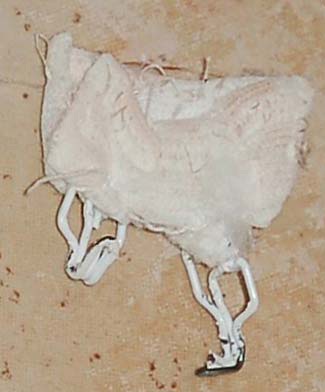 |
The
upper photo above is a view of the inside end of the right back strap. The
bottom photo is a view of the inside of the severed fabric clasp hook.
Both had been sewn together along with the end of the right shoulder
strap. Note the machine cut look to both pieces and the sewn appearance
to both pieces with loose threads seen in both as well. Also note that
one of the hooks has been heavily deformed and almost pulled apart from
the clasp fabric.
When
examining the severed fabric clasp hook section, one can detect where
it had been sewn together with the right bra strap end. When examining
the right bra strap end, one can detect where it had been sewn to the
fabric clasp hook and the right shoulder strap.
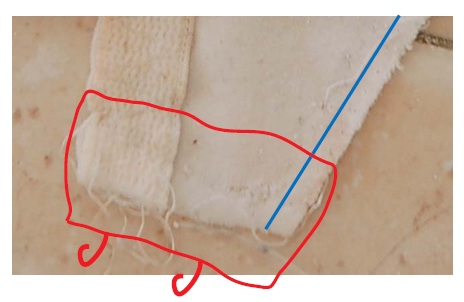 |
The illustration above shows how the fabric clasp and hook (red outline) was sewn attached to the end of the right bra strap. The blue line shows how the right shoulder strap had also been sewn both to the back strap and the inside of the fabric clasp and hook. Thus when the killer ripped off the right shoulder strap he also partially ripped the fabric clasp from the right bra strap.
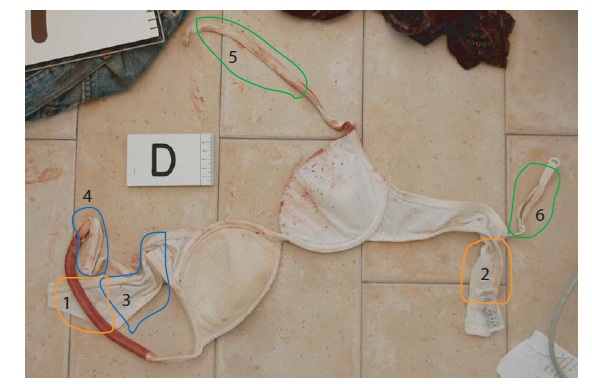 |
The
illustration above shows the three primary hand grips the killer used
to rip apart the victim’s bra. Handgrip zones 1 and 2 (orange) are the
locations the killer likely used to try and pull the back strap apart at
the hooks. Handgrips 3 and 4 (blue) were the locations the killer
likely used to rip the right shoulder strap off the bra strap and this
in turn likely partially separated the fabric clasp and hook piece.
Handgrips 5 and 6 (green) were the locations the killer likely used to
pull the left shoulder strap apart at the metal loop.
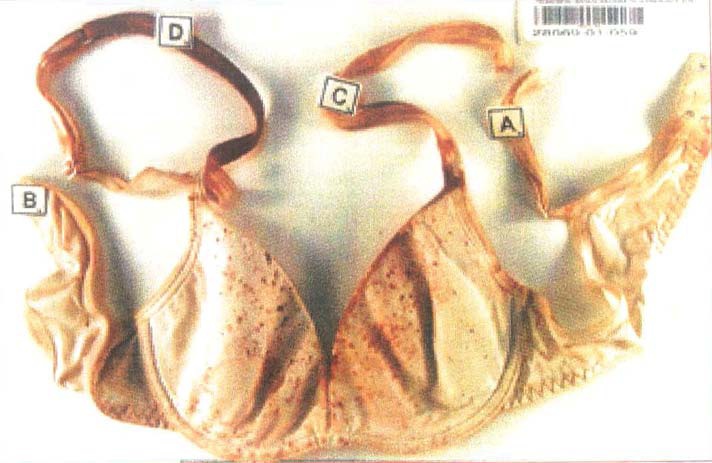 |
The photo above shows the bra from the Mignini Forensic Report. The
numbers apparently indicate four locations where DNA testing had taken
place by Forensic Biologist Stefanoni. Location A corresponds with
location 6 in the handgrip illustration. Location C is at one end of
location 5 in the handgrip illustration. Location B appears to somewhat
correspond with location 3 in the handgrip illustration. Location D is
outside the location 4 in the handgrip illustration. Stefanoni reported
finding Rudy Guede’s DNA only at location B.
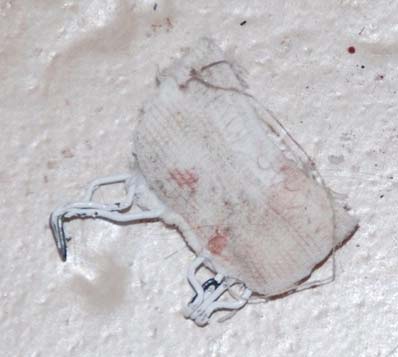 |
The photo above shows a view
of outside of clasp showing blood drops on the fabric. Forensic
Biologist Stefanoni sampled the fabric as one DNA test and sampled both
hooks as a second DNA test. She testified finding the DNA of the victim
and Raffaele Sollecito on the combined hook sample and only the victims
DNA on the fabric sample. The finding of Raffaele’s DNA on the combined
hook sample has been heavily disputed by the defense of Raffaele
Sollecito and Amanda Knox.
Likely scenario for ripping bra apart
The
killer likely initially briefly attempted to unhook the rear back
strap. When unable to quickly do that, the killer likely tried pulling
the back strap apart by gripping to either side of the hook and loop
connection. This almost succeeded as it pulled the top hook almost out
of its cloth attachment and deformed it. The killer likely next grabbed
the right shoulder strap with one hand and the right back strap with the
other and totally ripped the right shoulder strap away from the right
back strap. This almost tore the fabric clasp hook off from the back
strap as well. The killer then likely grabbed the fabric portion of the
clasp with the hand that had been gripping the shoulder strap and
finished pulling the fabric clasp from the right back strap. Next the
killer likely grabbed the left shoulder strap on both sides of the metal
loop and pulled the shoulder strap apart at the threaded connection of
the non adjustable strap.
Findings and observations
The
victim’s bra had been ripped or torn apart in all locations by brute
hand and arm force. The killer had not used a knife to cut the bra at
any of the severed locations. In addition, all the torn failures
occurred wholly at the threaded connections and not in the fabric pieces
that make up the bra.
The
killer was obviously still in an enraged state when he tore the bra
apart by hand. In order to induce all this damage by hand, the Killer
had gripped the bra in at least six separate locations and pulled apart
with enough force to likely rub off skin cells containing DNA. These six
locations were identified and are likely to contain sufficient DNA for
identification.
The
killer, Rudy Guede, was found with healing hand cut wounds and admitted
being cut in the hand when he was in the upstairs flat the night of the
murder. Therefore, in half of these tight gripping locations, the
killer’s own blood is likely to be found. The fabric portion of the
fabric clasp hook is another location of a possible strong grip for the
final separation of that piece from the right back strap.
The
hooks may not have even been touched during the removal action. A
normal unhooking of the back bra strap is done by gripping the adjacent
fabric and doesn’t require the hands to touch the hooks. Even if the
killer’s hands touched the fabric hooks, this contact would not likely
have been anywhere near as strong as the contact to the fabric to pull
the bra straps apart and thus would not likely have left a DNA signature
on
the hooks.
If
the killer’s blood was left anywhere in Meredith Kercher’s room, it was
likely left on the fabric portions of the bra during the several strong
gripping and pulling actions to
tear the bra apart.
A call for Independent DNA Testing
It
is this writer’s firm opinion from a review of the totality of the
physical evidence that Raffaele Sollecito was not in Meredith Kercher’s
room or the upstairs flat the night she was murdered.
However,
the Prosecution and indeed Presiding Judge Massei, maintained that
Raffaele Sollecito participated in the effort to remove the bra. Judge
Massei in his sentencing report said that Raffaele Sollecito “---,
finding himself behind Meredith, pulling on the bra with violence,
finally deciding to cut it) ---”. Massei says Raffaele cut the bra with
his own pocket knife.
The
gripping and pulling actions all occurred on the bra fabric. If
Raffaele participated in the violent pulling action to remove the bra,
then his DNA should show up in several locations on the bra fabric.
Therefore, an independent laboratory with no agenda or bias should be allowed to reexamine
and
test the bra for multiple indications of the killer’s enraged and
deranged behavior. In all likelihood any subsequent non biased testing
will find Rudy Guede’s DNA and blood all over the bra fabric with no
finding of Raffaele or Amanda.